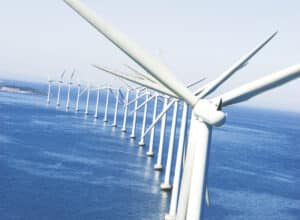A national pioneer in the production of wind energy, Ceará may receive the first wind farm offshore (installed in the sea) of Brazil. Last Wednesday (11), the Brazilian Institute for the Environment and Renewable Natural Resources (Ibama) held the first public hearing on this type of enterprise in the country in Fortaleza.
On the occasion, the Environmental Impact Report (Rima) of the “Offshore Wind Farm Caucaia” was presented, a project by BI Energia, a company that has Brazilian and Italian capital.
According to Lúcio Bonfim, a partner at the company, the expectation is that by the month of July this year, Ibama will issue its opinion on the Rima and grant the prior license for the enterprise.

“After that, we will prepare the executive project, which should take around twelve months. And then we will ask for the installation license. From then on, with all the licenses, it will take two years to build the project”, estimates Lúcio Bonfim.
Altogether, the complex foresees an investment of 1.166 billion euros, equivalent to R$ 6.1 billion. According to Bonfim, the resources will come from partner companies, investors and investment funds.
59 wind turbines
“Our company, which operates in Italy, has been developing projects in Brazil for over 10 years,” he says. And although the volume of investment is greater than that of conventional parks, the forecast is that the return on investment will come out in seven years, a period similar to that of traditional onshore projects (onshore). According to the BI Energia report, the complex will be able to supply up to 30% of energy consumption needs in Ceará. The project foresees the installation of 59 wind turbines, 48 of which in the open sea, capable of generating 576 megawatts (MW) of power in total, and another 11 with 2 MW of individual power (22 MW in total) at the end of 11 piers (structure ridge-like coastal area) that will be built along the coast of Caucaia.
The power forecast for the “Offshore Wind Farm Caucaia” corresponds to about 30% of all wind power installed today in Ceará.
opportunities
As a form of environmental compensation for the installation of the plant, the BI Energia project provides for the construction of breakwaters. And the company responsible for the works will be able to carry out, through a subsidiary company, the multi-annual concession of the marine areas within the breakwaters themselves, allowing these marine areas protected by the breakwaters to be economically exploited. In addition to the economic potential generated by the use of breakwaters, Bonfim highlights that the intervention should protect the beaches of Caucaia, Icaraí, Tabuba and Cumbuco from the advance of the sea. “These 11 ridges will solve the erosion problem in Caucaia, preventing this problem from reaching São Gonçalo do Amarante”, he says.
Efficiency
According to Bonfim, as they allow the construction of larger towers, equipped with large generators, offshore wind farms have a productivity efficiency rate above 60% of the total capacity, while plants installed on land are no more than 45% of use.
“Besides, at sea, you have a much better wind condition than you have on land. The large machines operating on land have 4 MW of power, while at sea, you can place a 12 M machine”, points out the businessman.
Ceará's potential
Thus, the engineer Jurandir Picanço, president of the Sectorial Chamber of Renewable Energies of Ceará (CS Renewables), evaluates that the offshore potential of the State is “giant”. “In Ceará, it was rated at 117 GW. Larger than onshore (94 MW). The quality of the wind is better, the wind turbines, because they are larger, have greater efficiency. It turns out that the investment is greater”, he points out.
Therefore, as for the feasibility of offshore projects, Picanço says that it depends on each project. “Worldwide, offshore wind is predicted to increase 15-fold over the next two decades, turning it into US$ 1 trillion in business. While the global offshore wind market grew by nearly 30% per year between 2010 and 2018, benefiting from rapid technological improvements. And the best locations for these projects could provide more than the total amount of electricity consumed worldwide today,” he says.
Professor and energy consultant João Mamede Filho believes that, as land for the installation of plants on the coast becomes scarcer. However, the trend is for the sector to migrate the generation to the sea and that, in this context. Therefore, Ceará has a competitive advantage over other states due to the low depth of the seabed to be explored.
“Therefore, offshore energy is already in common use in Europe due to the lack of land (for equipment installation). However, the issue still weighs in on the cost of these projects, which are much higher than onshore projects”, highlights the professor and energy consultant.
“In any case, Brazil should expand its production to the sea and we, in Ceará. We have this advantage of low depth, which helps to make projects viable. In addition, as for the electrical part, on the coast we have no connection problems”.
Project
Thus, the construction of offshore parks took shape with the approval by the Senate, at the end of last year. Although the project that regulates this type of generation. The projects will now depend on the next energy auctions launched by the Federal Government.
In the deployment ranges determined by the text approved by the Senate (between 22 and 370 kilometers from the coast). Therefore, the depth recorded in Ceará would be more favorable to this type of investment, being around 18 meters.


